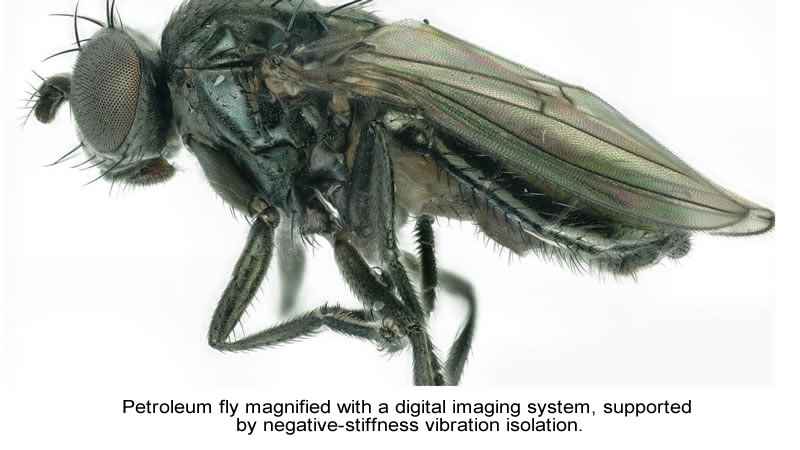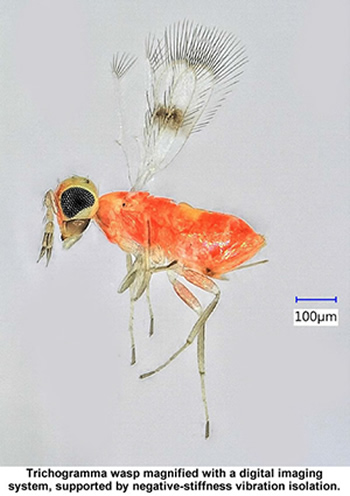
Lab Manager – July 2023
Vibration Isolation Improves Specimen Examination at the Natural History Museums of Los Angeles County
The museums' microscope is supported by negative-stiffness vibration isolation, which enables precise clarity of specimens being viewed at high magnification and high resolution

The Natural History Museums of Los Angeles County (NHMLAC), which include the Natural History Museum in Los Angeles' Exposition Park, the La Brea Tar Pits, and the William S. Harding Museum, is the largest natural and historical museum in the western United States, holding one of the world’s most extensive and valuable collections of natural and cultural history—more than 35 million specimens and artifacts covering 4.5 billion years of history.
The NHMLAC collections are strong in many fields, but the mineralogy and Pleistocene paleontology collections are among the most impressive, the latter thanks to the wealth of specimens collected from the La Brea Tar Pits located in the heart of Los Angeles. The world’s most powerful gateway to the Ice Age, the asphalt seeps at the La Brea Tar Pits represent the only active urban fossil dig site in the world. The site contributes an ongoing wealth of extraordinary specimens, like saber-toothed cats, mammoths, dire wolves, and mastodons, as well as the tiny microfossils of insects, plants, mammals, and reptiles from the last 50,000 years.
But more broadly, NHMLAC is widely recognized for building and preserving an impressive archive of objects, artifacts, and specimens from the natural world and human cultures across the globe, from billions of years ago to the present.
Examination of specimens
 Fundamental to the activities of NHMLAC is research. Essentially, close examination of these objects, artifacts, and specimens for the purposes of illustration, preparation of scientific papers for publishing, and photography for displays within the museum. Much of this research is conducted with the use of microscopy, viewing specimens at high magnification and high resolution to observe and examine fine details.
Fundamental to the activities of NHMLAC is research. Essentially, close examination of these objects, artifacts, and specimens for the purposes of illustration, preparation of scientific papers for publishing, and photography for displays within the museum. Much of this research is conducted with the use of microscopy, viewing specimens at high magnification and high resolution to observe and examine fine details.
“Researchers at the Natural History Museum in Exposition Park, for example, are examining the structure of prehistoric fish teeth, minerals, insects, and other small creatures,” said Brian Brown, PhD, curator of the Entomology Section. “Even ancient feathers from 100 million years ago encased in amber. Amber influences clarity and distorts and changes the viewability of the feathers. Very high microscopy resolution is needed to examine minute, fine details from these and other specimens.”
For the examination of its specimens, the museum uses a digital microscope.
Digital microscopes incorporate observation, image capture, and measurement capabilities while providing an on-screen interface for viewing objects. Compared to conventional optical microscopes, digital microscopy provides superior imaging capabilities. Even at higher magnification, images are fully focused due to a large, depth- of-field composition function.
“The digital imaging system gives us up to 1,000 times magnification,” continued Brown. “The microscope allows us to view great detail and fidelity in our specimens.”
Vibration problem
For several years ambient vibrations severely plagued the microscope’s ability to deliver precision images.
“At high magnifications things get very sensitive,” added Brown. This requires great stability. But our microscope is located on the third floor of the Entomology Section in the museum, in a cantilevered room extending from the main building. An elevator is located right next to the room, so we were constantly dealing with vibration issues that were affecting the quality of our images. We would wait for periods of relative stability, like between elevator movement, to view images. Even if the elevator was not running, we would still get ambient vibrations from people walking around in the department.”
Vibration can be caused by a multitude of factors within a building. Every structure is
transmitting noise. Within the building itself the heating and ventilation system, fans, pumps, compressors, elevators, doors closing, and footfall are just some of the sources that create low-frequency vibration that will affect microscopy imaging and data sets. Depending on how far away the microscopy instrumentation is from these vibration sources, and where in the structure the instrumentation is located—whether in a basement or in a cantilevered room—will determine how strongly the instrumentation will be influenced.
External to the building, sensitive instrumentation can be influenced by vibrations from truck movement, road traffic, nearby construction, loud noise from aircraft, and even wind and other weather conditions that can cause movement of the structure.
“Essentially, we were getting so-so results from the microscope, and we knew the problem was coming from the ambient vibrations in the room,” explained Brown. “We tested an active cancellation vibration isolation system, but found it hard to set up, and it really did not cancel vibrations very well. We then did a demonstration of a negative- stiffness passive vibration isolation system and found it to perform very well.”
Negative-stiffness vibration isolation
Negative-stiffness vibration isolators are compact and do not require electricity or compressed air, which enables sensitive instruments to be located wherever a production facility, laboratory, or observatory needs to be set up, whether that be in a basement, on a building’s vibration-compromised upper floors, or rooftop. There are no motors, pumps, or chambers, and no maintenance because there is nothing to wear out. They operate purely in a passive mechanical mode.
What is very advantageous about these isolators is that they achieve a high level of isolation in multiple directions. These isolators have the flexibility of custom tailoring resonant frequencies to 0.5 Hz* vertically and horizontally (with some versions at 1.5 Hz horizontally).
(Note that for an isolation system with a 0.5 Hz natural frequency, isolation begins at 0.7 Hz and improves with increase in the vibration frequency. The natural frequency is more commonly used to describe the system performance.)
Vertical-motion isolation is provided by a stiff spring that supports a weight load, combined with a negative-stiffness mechanism. The net vertical stiffness is made very low without affecting the static load-supporting capability of the spring. Beam-columns connected in series with the vertical-motion isolator provide horizontal-motion isolation. A beam-column behaves as a spring combined with a negative-stiffness mechanism. The result is a compact passive isolator capable of very low vertical and horizontal natural frequencies and very high internal structural frequencies.
Negative-stiffness isolators deliver very high performance, as measured by a transmissibility curve. Vibration transmissibility is a measure of the vibrations that are transmitted through the isolator relative to the input vibrations. Negative-stiffness isolators, when adjusted to 0.5 Hz, achieve approximately 93 percent isolation efficiency at 2 Hz; 99 percent at 5 Hz; and 99.7 percent at 10 Hz.
Performance
“The negative-stiffness isolator has performed very well for us,” said Brown. “It allows us to have sharper images at higher magnifications. It makes our images better. We do not even think about the elevator anymore, or any other vibrations. They no longer have influence on our microscope’s magnifications.”
|